New approach needed to take the conflict out of the streets of the future, urges report

- Report finds at least 160 legitimate calls on street space and that current tools for street management are ‘rudimentary and often ineffective’
There are at least 160 legitimate calls on street space - from cycle lanes to access for removal vehicles and from street furniture to taxi drop off - and they cannot all be met. These challenges are likely to intensify as home deliveries increase, the weather becomes more extreme and more electric vehicles require charging.
These are the key findings of a new report from Urban Movement for the Urban Transport Group, which calls for a fresh approach to remove the conflict from the competing demands for street space.
The report describes the tools currently used to manage street space as ‘rudimentary and often ineffective’, which are exacerbating the problems of congestion, air pollution, noise, road safety and carbon emissions. It also argues that a tendency to address different priorities for street space in isolation from each other and a lack of adequate resourcing for local transport authorities further contribute to streets often being ‘the most contested spaces in any town or city.’
The report concludes:
“To enable streets to be more effectively and efficiently managed first requires the Government, highway authorities and strategic transport authorities to recognise the need for a more holistic approach. From this should follow better coordination of relevant policy, strategy and funding. There will also need to be an increase in local government capacity and resources dedicated to managing the use of street space. These changes will form the basis of more effective partnerships with transport operators, service providers and others to work together towards clear, shared goals for mutual benefit.”
The report recommends that:
- there should be greater recognition in national strategies for individual modes and policies (from Zero Emission Vehicles to cycling) of the wider calls on streetspace and therefore on relative priorities between modes and uses of street space
- there should be better resourcing of the capabilities and capacities of local highway and transport authorities to better manage street space
- the kerbside (where many of the conflicts around street space are focussed) should be defined in a way that all those with differing responsibilities for it understand and that forthcoming guidance on new Local Transport Plans should require local kerbside strategies
- more use should be made of new technologies including thorough ‘digitising’ of the kerbside to make available online information on access, waiting and loading restrictions and through trials and pilots of kerbside management concepts (such as using technology to vary the allocation of street and kerbspace at different times of day rather than relying on static signs and painted lines).
John Dales, Director of Urban Movement, and the author of the report, said:
“We need our streets to enable people and goods to move around in ways that minimise carbon emissions and pollution. We need them to be more efficient as enablers of exchange and commerce. We need them to be places that are clean and safe, that are enjoyable to be in, that promote greater climate resilience, that are equitable and accessible, that are welcoming to people of all ages and backgrounds, and that facilitate social interaction. It is evident that, today, most of our streets are not like this.
“But if we grasp their full potential, realise their true value, develop coordinated management strategies, work in partnership, and thereby make a stronger case for investment, our future streets will help us to meet the challenges we face, not add to them.”
Jonathan Bray, Director of the Urban Transport Group, said:
“We need to move beyond continually coming back to streets with single-issue agendas and instead find more sophisticated and holistic approaches to what are very complex and challenging trade offs given that legitimate demands on street space often far exceeds the available space. We hope that this report will help in triggering the debate that needs to happen about the future of streets.”
Related content
Report

